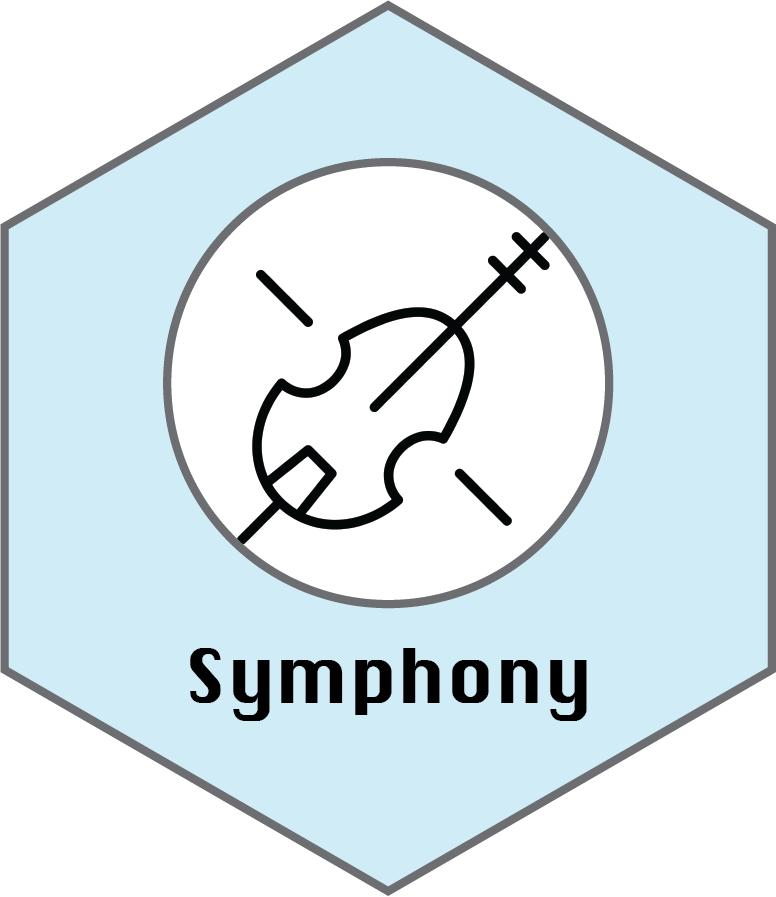

Efficient and precise single-cell reference atlas mapping with Symphony
For Python users, check out the symphonypy package by Kseniya Petrova and Sergey Isaev.
Symphony is available on CRAN:
install.packages("symphony")Install the development version of Symphony from GitHub use:
# install.packages("devtools")
devtools::install_github("immunogenomics/symphony")Install should take <10 mins (pending no major issues). See installation notes below.
Check out the quick start (<5 min) PBMCs tutorial for an example of how to build a custom reference and map to it.
Check out the pre-built references tutorial for examples of how to map to provided Symphony references pre-built from the datasets featured in the manuscript.
This function compresses an existing Harmony object into a Symphony reference that enables query mapping. We recommend this option for most users since it allows your code to be more modular and flexible.
# Run Harmony to integrate the reference cells
ref_harmObj = harmony::HarmonyMatrix(
data_mat = t(Z_pca_ref), # starting embedding (e.g. PCA, CCA) of cells
meta_data = ref_metadata, # dataframe with cell metadata
theta = c(2), # cluster diversity enforcement
vars_use = c('donor'), # variable to integrate out
nclust = 100, # number of clusters in Harmony model
max.iter.harmony = 10, # max iterations of Harmony
return_object = TRUE, # set to TRUE to return the full Harmony object
do_pca = FALSE # do not recompute PCs
)
# Build Symphony reference
reference = buildReferenceFromHarmonyObj(
ref_harmObj, # output object from HarmonyMatrix()
ref_metadata, # dataframe with cell metadata
vargenes_means_sds, # gene names, means, and std devs for scaling
loadings, # genes x PCs
verbose = TRUE, # display output?
do_umap = TRUE, # run UMAP and save UMAP model to file?
save_uwot_path = '/absolute/path/uwot_model_1' # filepath to save UMAP model)Note that vargenes_means_sds requires column names
c('symbol', 'mean', 'stddev') (see tutorial
example).
This function performs all steps of the reference building pipeline including variable gene selection, scaling, PCA, Harmony, and Symphony compression.
# Build reference
reference = symphony::buildReference(
ref_exp, # reference expression (genes by cells)
ref_metadata, # reference metadata (cells x attributes)
vars = c('donor'), # variable(s) to integrate over
K = 100, # number of Harmony soft clusters
verbose = TRUE, # display verbose output
do_umap = TRUE, # run UMAP and save UMAP model to file
do_normalize = FALSE, # perform log(CP10k) normalization on reference expression
vargenes_method = 'vst', # variable gene selection method: 'vst' or 'mvp'
vargenes_groups = 'donor', # metadata column specifying groups for variable gene selection within each group
topn = 2000, # number of variable genes (per group)
theta = 2, # Harmony parameter(s) for diversity term
d = 20, # number of dimensions for PCA
save_uwot_path = 'path/to/uwot_model_1', # file path to save uwot UMAP model
additional_genes = NULL # vector of any additional genes to force include
)Once you have a prebuilt reference (e.g. loaded from a saved .rds R object), you can directly map cells from a new query dataset onto it starting from query gene expression.
# Map query
query = mapQuery(query_exp, # query gene expression (genes x cells)
query_metadata, # query metadata (cells x attributes)
reference, # Symphony reference object
vars = NULL, # Query batch variables to harmonize over (NULL treats query as one batch)
do_normalize = FALSE, # perform log(CP10k) normalization on query (set to FALSE if already normalized)
do_umap = TRUE) # project query cells into reference UMAPquery$Z contains the harmonized query feature
embedding.
If your query itself has multiple sources of batch variation you
would like to integrate over (e.g. technology, donors, species), you can
specify them in the vars parameter:
e.g. vars = c('donor', 'technology')
Symphony has been successfully installed on Linux and Mac OS X using the devtools package to install from GitHub.
Dependencies:
install_github to fail).devtools::install_github("immunogenomics/harmony")We have been notified of the following installation errors regarding
systemfonts, textshaping, and
ragg (which are all required by ggrastr):
# error when installing systemfonts
ft_cache.h:9:10: fatal error: ft2build.h: No such file or directory
# error when installing textshaping
Configuration failed to find the harfbuzz freetype2 fribidi library
# error when installing ragg
<stdin>:1:10: fatal error: ft2build.h: No such file or directoryThese errors are not inherent to the Symphony package and we cannot
fix them directly. However, as a workaround, you can install
systemfonts, textshaping, and
ragg separately using install.packages() and
specify the path to the required files (replacing /path/to
below with the path to the appropriate include directory
containing the files).
# fix to install systemfonts
withr::with_makevars(c(CPPFLAGS="-I/path/to/include/freetype2/"), install.packages("systemfonts"))
# fix to install textshaping
withr::with_makevars(c(CPPFLAGS="-I/path/to/include/harfbuzz/ -I/path/to/include/fribidi/ -I/path/to/include/freetype2/"), install.packages("textshaping"))
# fix to install ragg
withr::with_makevars(c(CPPFLAGS="-I/path/to/include/freetype2/"), install.packages("ragg"))Code to reproduce Symphony results from the Kang et al. manuscript is available on github.com/immunogenomics/symphony_reproducibility.